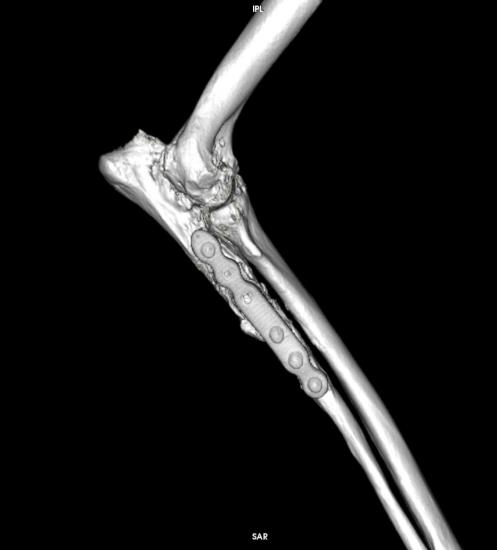Categories
Proximal Abducting Ulnar Osteotomy (PAUL) in dogs
By Eastcott Referrals Orthopaedic Surgeon Fabio Frazzica
A common cause of canine thoracic limb lameness in patients that are referred to us is elbow dysplasia
Elbow dysplasia is a complex orthopaedic condition resulting from the abnormal development of the elbow joint, which can lead to loss of articular cartilage, often localised to the medial compartment of the joint. This can cause chronic pain and debilitating lameness.
The Proximal Abducting Ulnar Osteotomy (PAUL) is a procedure that aims to shift the weight bearing axis away from the damaged medial compartment of the elbow joint. This is done by modifying the shape of the proximal ulna by cutting this bone just below the elbow joint and applying a specially designed plate.
The PAUL procedure is one of a number of techniques that we offer to manage elbow pain in medium to large breed dogs. We have found that the results are best in young dogs prior to the onset of severe osteoarthritis, and when conservative treatment options have failed or are not deemed appropriate.
We routinely perform preoperative and postoperative CT scans in patients undergoing PAUL procedures in order to get the maximum amount of information on the condition of the joint that we are aiming to treat, the shape of the ulna and to assess the success of the procedure afterwards.
The image below shows an example of a PAUL procedure that was performed on a 3-year-old male Labrador. This patient had not improved following a 3-month treatment regime consisting of anti-inflammatory and pain relief medications and exercise restriction.
Approximately 4 months postoperatively, once the bone had fully healed, the patient was able to resume his normal activity levels without the need to take pain relief medications.
This procedure was performed by Orthopaedic Surgeon Fabio Frazzica and our team of Orthopaedic Nurses and Interns.

